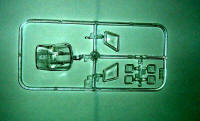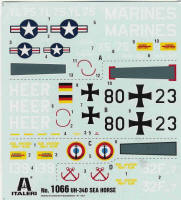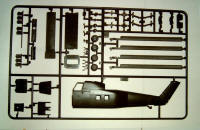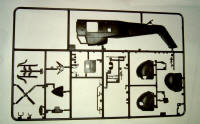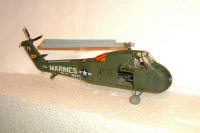|
Italeri 1/72 Sikorsky UH-34J Sea Horse |
|
|
Kit Number 1066 |
|
|
Reviewed By Howie Belkin, #16 |
|
|
|
|
|
MSRP: $17.50 USD Injection molded 70 olive drab and 7 clear parts; decals for 4 aircraft.
Sikorsky's S-58 (military versions were renamed H-34 after Sept. 1962) succeeded its highly successful H-19 sister, first flying in March 1954 with over 2,400 built when production ceased in early 1970. It had over two dozen designations branching from four main limbs of the H-34 family tree according to Squadron/Signal’s H-34 Choctaw in Action, an excellent reference. They were the US Navy HSS-1 and HSS-1N Seabat; the US Army H-34 Choctaw; the US Marines HUS-1 Seahorse and the S-58. She saw civilian or military service in over four dozen nations. The H-34 was the last helicopter designed with a piston engine and was later incarnated with turbine power as the Westland Wessex. While the U.S. Army flew H-21s in early 1960s Vietnam, the Marines flew UH-34s.
Italeri has re-released their 1/72 UH-34 kit (i.e. as the Wessex) which is still “good as new” and cleanly molded with fine engraved and raised panel lines. With all those variants it’s not surprising that the box reads “J” model and the instructions refer to a “D.” Essentially the differences are outside this review’s scope, aside from advising you to decide which version you’re building and follow the directions as you have some options – and note that Marine pilots in ‘Nam affectionately called the UH-34D “the Dog.” A most obvious difference is the choice of two left nose halves for different exhaust layouts. The other major option is your choice of .30 cal or M-60 machine gun (correct without aviator grips) or 20mm cannon armament for the door gunner. Look for the “drill holes” symbol to accommodate antennas and landing gear. The cockpit side windows and cargo door can be left open or closed (as clear as the clear parts are, I still dipped them in Future because it’s worked so well in the past). The cockpit interior is detailed including the overhead control panel on the inside of the canopy part, but Italeri forgot the easily added cyclic control stick along the left side of each seat. Instrument and control panels are all raised detail instead of decals. Only a judge with his flashlight would see the cabin interior wall ejection pin marks and lack of a ceiling so if you want a contest winner, spring for Cobra Company’s resin interior or a photo etched one from Eduard or Airwaves. Otherwise, Italeri’s canvas seating and bulkheads are nicely done and not all USMC photos (check www.popasmoke.com) show insulation blankets on the interior walls. It’s hard to top Italeri helicopter kits: even the simplified rotor head looks good out of box and the main rotor blades have the characteristic droop (I folded mine for maintenance – and to save shelf space). The tail rotor blades should rotate clockwise (facing it), but that’s fixed by cutting off the shaft and cementing it on the other side of the hub, then inserting the shaft in the original side (port) of the tail assembly. Some filler was needed after gluing the nose to the fuselage, the windscreen and the belly and main rotor roof panel. I painted the rear transmission cover orange-yellow with black tiger stripes before cementing, used the .30 cal (glued before closing the fuselage halves) and changed decals to represent a HMM-361 “Flying Tiger” like one recently restored here on Long Island. The cover’s vents are so well done that there is “air” between each one. The molded screen mesh in the upper nose is excellent with a dark wash and dry-brush. A real contender would cut it out and insert photo etch screen, then blank off the empty exposed cavity or better yet, fill it with a detailed engine compartment opening up the clamshell doors for all the world to see. I clammed up and kept it shut. Italeri correctly includes the small triangle “elephant ear” navigation light extensions and copilot’s exhaust glare shield, but if you build a later version use the M60 m.g. and add welded on armor plate (something our troops have been doing long before Iraq). The kit provides markings for a USMC Vietnam overall field green FS 34097 H-34 #75 HMM-362 1962 with orange-yellow transmission cover (no stripes); a German Army olive green H-34G-2 #80+23 1966; and two French Navy insignia blue: a MSS-1 #139 1975 and the second a HSS-1 #32F-7 Algeria 1959. The matt decals are in perfect register with minimal carrier film and worked well with Future floor wax and Testor’s Dullcote. I painted the top of the main rotor blades early Vietnam war light grey and flat black undersides with yellow tips and black with red and white stripes on the tail blades. Once dry I added the cabin door, rotors, pitot tube and antennas – everything that would have fogged or broken off if not left for last. Italeri has been steadily releasing (and re-) 1/72 scale models that I can highly recommend, and offer what may be the very best helicopter collection. This UH-34 is a simple build with a handful of scale sized parts that require some manual dexterity. The “Dog” can also be the AMS afflicted best friend giving him a leg up towards satiating that trophy hound within. Thanks to Testors for the review sample. You can get yours at better hobby shops or order from www.testors.com or www.italeri.com. Now imagine an Italeri Sikorsky R-4, S-51 Dragonfly with Mickey Rooney figure, and S-56 Mojave; a Bell Vietnam era AH-1G Cobra and a Piasecki H-25/HUP and I’m in helicopter heaven. |
|
|
Information, images, and all other items placed electronically on this site are the intellectual property of IPMS/USA ®. |
|

